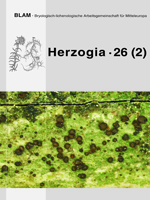Döbbeler, P. & Hertel, H. 2013. Bryophilous ascomycetes everywhere: Distribution maps of selected species on liverworts, mosses and Polytrichaceae. — Herzogia 26: 361–404.
The biogeographical distributions of 21 selected species of ascomata-forming fungi that grow obligately on bryophyte gametophytes have been compiled and are presented as 27 dot maps. The maps are based on more than 1370 records, combing all hitherto published records (more than 970) with nearly 400 additional ones, cited here for the first time. Examples are given for European, holarctic, neotropical, tropical Afro-American, pantropical, Australasian, australsubantarctic, bipolar, nearly cosmopolitan, and endemic distribution patterns. Ten maps are devoted to nine fungal species found on foliose hepatics (Bryocentria brongniartii, Calonectria frullaniae, Dactylospora heimerlii, Epibryon deceptor, E. filiforme, E. pedinophylli, Octosporella jungermanniarum, Stenocybe nitida, Ticonectria perianthii), two maps refer to a species found on pleurocarpous mosses (Acrospermum adeanum), and 15 maps show the distributions of eleven taxa found on Polytrichaceae (Bryochiton perpusillus, Biyonectria phyllogena, Bryorella cryptocarpa, Dawsophila callichroma, D. polycarpa, Epibryon elegantissimum, E. pogonati-urnigeri, Hymenoscyphus erythropus, Lizonia sexangularis, Potridiscus polymoiphus, Potriphila navicularis). Host species are represented by liverworts (18 species), Polytrichaceae (29 species), and a few pleurocarpous mosses. Several new fungus-host relationships are revealed. Particular emphasis is placed on the multitude of systematically and biologically diverse groups to which these parasites belong. Sixteen genera from seven classes of Ascomycota are represented. Biological diversity is reflected in the varying degrees of host specificity, biotrophic or necrotrophic parasitism, and the colonization of distinct microniches (e.g. perianths of epiphyllous liverworts, interlamellar leaf spaces or male antheridial cups in Polytrichaceae). Some parasites are so common that screening potential host collections is a rewarding method of discovery. Other taxa are so rare that their observation was accidental and fortuitous, even in well-studied host groups. Bryochiton perpusillus and Epibryon pogonati-urnigeri, both occurring on a variety of Polytrichaceae, are the most well-documented species, with 234 and 236 records respectively. As it is typical of most obligate parasites such as the lichenicolous fungi, bryophilous ascomycetes tend to occur within the wider distribution ranges of their hosts. There are only a few examples of species whose distributions seem to be restricted to only a part of the area occupied by their hosts. Calonectria frullaniae, Potridiscus polymorphus, and Ticonectria perianthii are three such exceptions. The maps verify the hitherto largely ignored fact that many ascomycetes are widespread, and are regularly associated with bryophytes.





